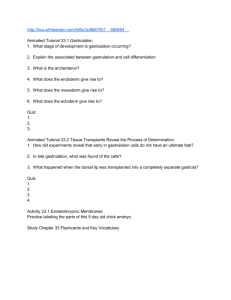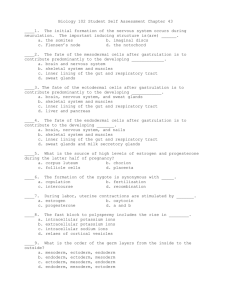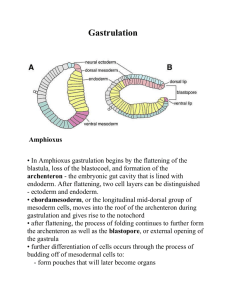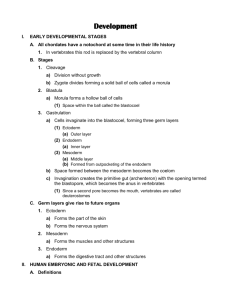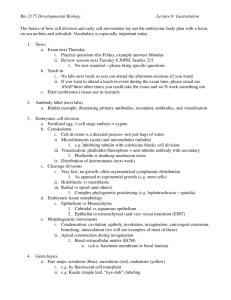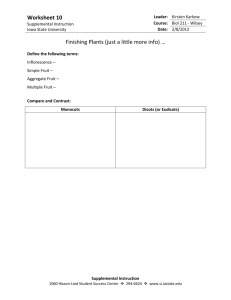Animal Development part1
advertisement
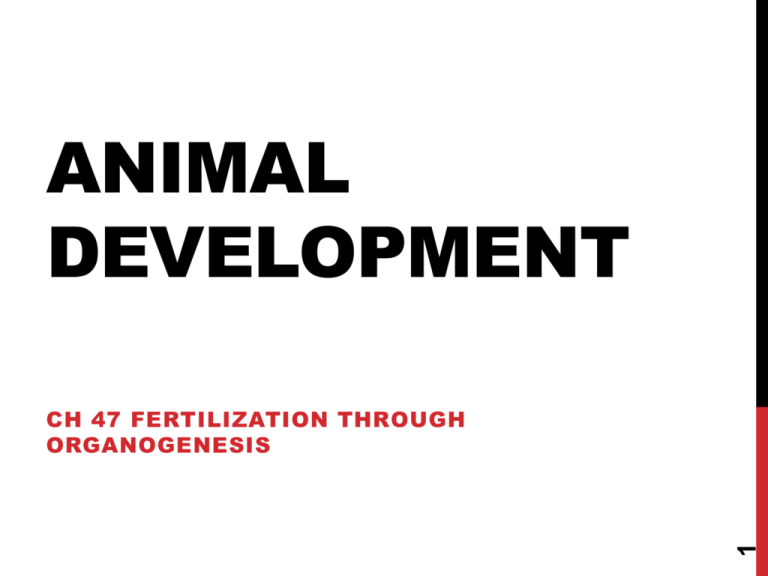
ANIMAL DEVELOPMENT 1 CH 47 FERTILIZATION THROUGH ORGANOGENESIS STAGES OF HUMAN DEVELOPMENT 1. Fertilization 1. Zona pellucida 2. First cell division 2. Cleavage 1. Blastomere 2. Holoblastic cleavage 3. Meroblastic cleavage 4. regulation 3. Morophogenesis Gastrulation Organogenesis 2 1. 2. FERTILIZATION Female secretions increase sperm motility and change structure to cause fertilization potential (capacitation) Moist environment necessary for sperm 3 First six hours FERTILIZATION Zona pellucida contain receptor cite and acrosomal reaction which binds sperm to egg Changes cause slow polyspermy to prevent additional sperm from entering egg 4 No fast polyspermy reactions in mammals FIGURE 47.5 Zona pellucida Follicle cell Cortical granules 5 Sperm basal body Sperm nucleus FERTILIZATION First Cell Division Mitosis forms true nuclei in daughter cells 12-36 hours after sperm bonding Each cell is now a blastomere 6 http://www.hhmi.org/biointeractive/human-embryonic-HHMI embryonic development CLEAVAGE Rapid cell division with almost continuous S and M phases of cell cycle Little or no protein synthesis (G1 or G2) 7 Blastula- Hollow ball of cells form with blastocoel cavity FIGURE 47.6 50 m (b) Four-cell stage (c) Early blastula (d) Later blastula 8 (a) Fertilized egg CLEAVAGE In frogs and mammals is holoblastic “holo” means complete Humans have 3 divisions in first three days with little yolk forming Birds and reptiles cleavage is meroblastic (incomplete) to get extensive yolk formation The “ends” of the blastula are called the animal pole and vegetal pole 9 Gray crescent is the area on the opposite side from sperm binding FIGURE 47.7 Zygote 2-cell stage forming Gray crescent 0.25 mm 8-cell stage (viewed from the animal pole) 4-cell stage forming 8-cell stage Animal pole 0.25 mm Blastula (at least 128 cells) Blastula (cross section) Blastocoel 10 Vegetal pole REGULATION OF CLEAVAGE The total mass of the structure does not change from zygote to blastula, the cells just get smaller Cells divide until the ratio of material in each nucleus to cytoplasm is sufficiently large 11 Small cells balance the amount of DNA to mRNA for protein synthesis (think surface are to volume ratio) MORPHOGENESIS Transformation of embryo orientation and shape Important is the cell shape, position and survival Two important phases: 1. Gastrulation- establishment of cell layers 12 2. Organogenesis- formation of organs MORPHOGENESIS: GASTRULATION During gastrulation there is a mass movement of cells which results in the blastula becoming a gastrula Three germ layers develop ectoderm- outside layer mesoderm- middle layer endoderm- inside layer Some organisms (cniderians) do not have a mesoderm HHMI Differentiation and Cell Fate 13 http://www.hhmi.org/biointeractive/differentiation-and-fatecells FIGURE 47.8 ECTODERM (outer layer of embryo) • Epidermis of skin and its derivatives (including sweat glands, hair follicles) • Nervous and sensory systems • Pituitary gland, adrenal medulla • Jaws and teeth • Germ cells MESODERM (middle layer of embryo) • Skeletal and muscular systems • Circulatory and lymphatic systems • Excretory and reproductive systems (except germ cells) • Dermis of skin • Adrenal cortex • Epithelial lining of digestive tract and associated organs (liver, pancreas) • Epithelial lining of respiratory, excretory, and reproductive tracts and ducts • Thymus, thyroid, and parathyroid glands 14 ENDODERM (inner layer of embryo) FIGURE 47.9 Animal pole Blastocoel Mesenchyme cells Gastrulation in Sea Urchin Vegetal plate Vegetal pole Blastocoel Filopodia Mesenchyme cells Blastopore Archenteron 50 m Blastocoel Ectoderm Future ectoderm Future mesoderm Future endoderm Mouth Mesenchyme (mesoderm forms future skeleton) Blastopore Digestive tube (endoderm) Anus (from blastopore) 15 Key Archenteron FIGURE 47.10 1 CROSS SECTION SURFACE VIEW Animal pole Blastocoel Gastrulation in Frog Dorsal lip of blastopore Early Vegetal pole gastrula Blastopore Blastocoel shrinking 2 3 Blastocoel remnant Dorsal lip of blastopore Archenteron Ectoderm Mesoderm Endoderm Future ectoderm Future mesoderm Future endoderm Late gastrula Blastopore Blastopore Yolk plug Archenteron 16 Key FIGURE 47.11 Fertilized egg Primitive streak Gastrulation in Chick Embryo Yolk Primitive streak Epiblast Future ectoderm Blastocoel Endoderm Hypoblast YOLK 17 Migrating cells (mesoderm) 1 Blastocyst reaches uterus. Gastrulation in Human Uterus Endometrial epithelium (uterine lining) Inner cell mass Trophoblast Blastocoel 2 Blastocyst implants (7 days after fertilization). Expanding region of trophoblast Maternal blood vessel Epiblast Hypoblast Trophoblast 3 Extraembryonic membranes start to form (10–11 days), and gastrulation begins (13 days). Expanding region of trophoblast Amniotic cavity Epiblast Hypoblast Yolk sac (from hypoblast) Extraembryonic mesoderm cells (from epiblast) Chorion (from trophoblast) 4 Gastrulation has produced a three-layered embryo with four extraembryonic membranes. Amnion Chorion Ectoderm Mesoderm Endoderm Yolk sac Extraembryonic mesoderm Allantois 18 FIGURE 47.12 MORPHOGENESIS: GASTRULATION IN HUMANS 1. Blastocyst first 6 days Fertilization occurs in the oviduct Inner cell mass becomes the embryo which is the source for stem cells Inner cell mass Little yolk (stored nutrients) 19 Blastocyst reaches uterus. MORPHOGENESIS: GASTRULATION IN HUMANS 2. Trophoblast 7 days after fertilization Outer epithelium secretes enzymes for implantation which allows for blood to surround trophoblast Epiblast-upper layer becomes the embryo Hypoblast- lower layer 20 Maternal blood vessel MORPHOGENESIS: GASTRULATION IN HUMANS 3. Extraembryonic membranes 10-11 days Formed by embryo Enclose special structures outside the embryo Gastrulation begins day 13 when implantation is complete Cell migration occurs as cells move inward from epiblast through primitive streak to form mesoderm and endoderm 21 Chick gastrulation FIGURE 47.12C Expanding region of trophoblast Amniotic cavity Epiblast Hypoblast Yolk sac (from hypoblast) Extraembryonic mesoderm cells (from epiblast) 22 Chorion (from trophoblast) 3 Extraembryonic membranes start to form (10–11 days), and gastrulation begins (13 days). MORPHOGENESIS: GASTRULATION IN HUMANS 4. End of gastrulation Three germ layers are formed Extraembryonic layers from placenta 23 These layers are an evolutionary necessity in land (dry) environments FIGURE 47.12D Amnion Chorion Ectoderm Mesoderm Endoderm Yolk sac Extraembryonic mesoderm Allantois 24 4 Gastrulation has produced a three-layered embryo with four extraembryonic membranes. ORGANOGENESIS More localized changes Spinal cord Bones (or specific) skin heart intestine liver Muscles (or specific) eyes ears HHMI 25 Research brain
